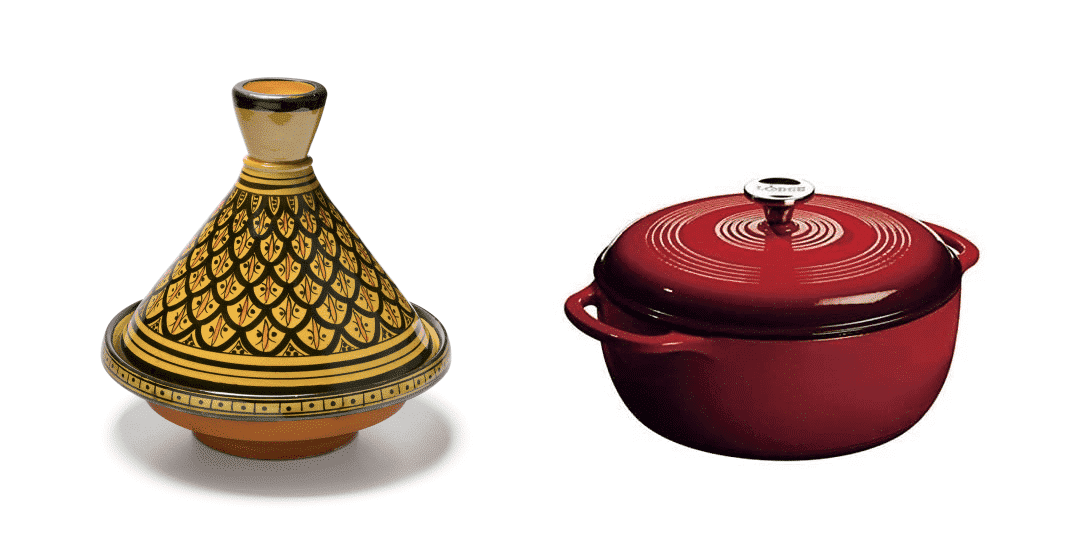
If quarantine has got you cooking, we are pretty sure you would be comparing different cookware and checking how changing the appliance will impact the food. Similarly, the queries regarding Tagine Vs Dutch Oven is increasing. So, in this article, we are comparing the differences between both. However, before we start off with the differences, keep in mind that both of them are famous for tender food as they trap in steam and moisture to evenly cook the food!
Tagine vs Dutch Oven
Tagine
To begin with, tagine is defined as a cooking dish that’s made from clay. However, there are cast-iron and aluminum tagines available as well. The tagines are suitable for stoves as well as the ovens. The tagine is more of a slow cooker because the food will take its sweet time to cook in the tagine. They are designed in a conical shape while the lid helps trap the steam.
The tagine is designed with a shallow yet wide base while the steam keeps rising to the top. Also, we have said that it can be used in ovens and stovetops, but using it on the stovetop will demand carefulness. That’s to say, because tagines usually have clay construction, and higher temperatures will lead to cracking.
In the case of clay tagines, there are unglazed as well as glazed variants. We suggest that you use the heat diffuser with tagines when using it on the stovetop. With this being said, the low temperature and long cooking times are suitable for tagines since higher temperatures might lead to cracking. However, modern tagines are available in ceramic, cast-iron, and stainless steel.
With these different materials, the higher temperature can be used, but it might strip away the earthy taste from the food. As far as the sizes are concerned, tagines are measured in inches, ranging from ten inches to 16 inches. The biggest tagine with 16 inches size is suitable for cooking food for eight people at a time. In contrast, the smallest tagine is only sufficient to cook for one person.
Pros
The tagines are perfect for people who like tender and juicy food since it seals in the moisture for even cooking. Also, the unglazed tagine will bring an earthy feel to the food. The best part is that the tagine can be used as the serving pot, so straight out of the stove to the dining table.
Con
To be honest, tagine is not the easiest cookware to use out there. For instance, the unglazed tagines need seasoning every time you’ve to cook. Also, they aren’t as versatile since they are only suitable for slow cooking.
Dutch Oven
A Dutch oven is defined as the enamel-coated cast-iron, which can be extensively used for boiling, roasting, frying, and making soups. As for usability, they are suitable for ovens and stovetops. The Dutch oven usually has a cylindrical shape, which is made from ceramic as well as cast-iron. The lid is designed with tight-fitting that helps lock in the moisture and heat.
This is actually in benefits since the retained heat, moisture, and steam can be used for evenly cooking the food. As a result, the food is cooked with even and tender consistency. In addition, the users can cook on the stovetop and transfer the Dutch oven to the oven. With this being said, it can be named as versatile cookware.
As far as the application is concerned, the Dutch oven can be used for making stews, casseroles, and bread. Earlier, the Dutch ovens were only available in cylindrical shapes. Still, nowadays, they are available in rectangular, round, and square shapes, but none of them impact the functionality. Also, their sizes are measured in quarts, ranging from ¼ to 15. The 15-quart Dutch ovens are pretty huge for one supper.
Pros
The biggest flex of the Dutch oven is the versatility since it can be used to bake, roast, fry, make stews and soup, along with casserole-making. In addition, cleaning the Dutch oven is comparatively easier since they have a simple design. Above all, Dutch ovens are designed to last for years since they have a hard-wearing nature. Also, these ovens aren’t prone to rust if there is proper seasoning involved.
Cons
The only downside of the Dutch oven is that it can be pretty expensive. But again, they are designed to last, so you will eventually get the value of your money!